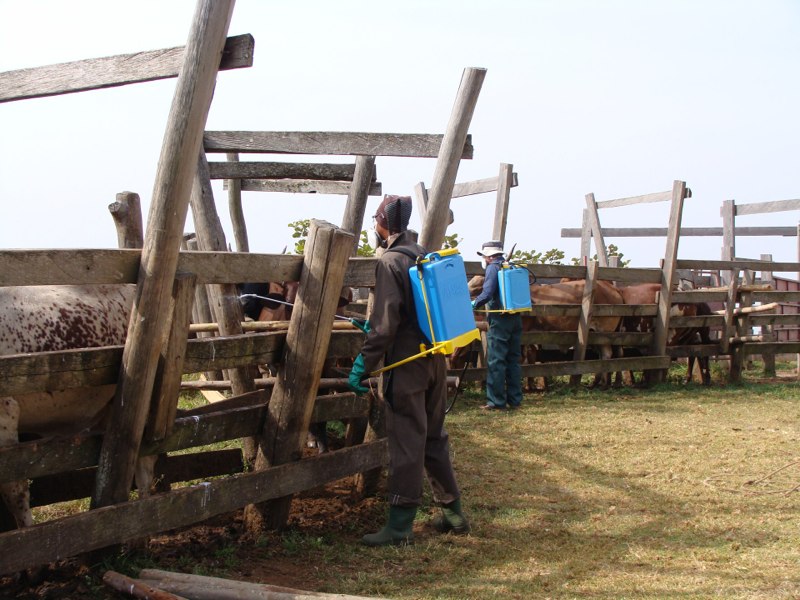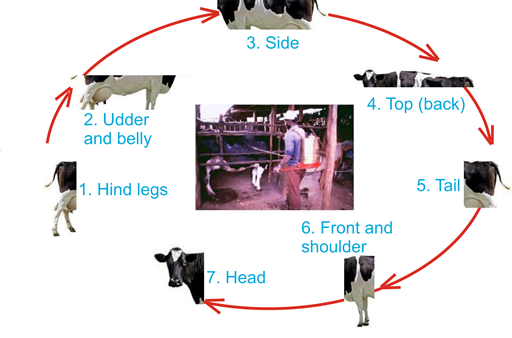Guidelines for spraying livestock

Regular spraying of livestock safeguards against pests such as ticks, tsetse-fly, biting flies, lice and fleas. In the long run the aim is to control the spread of diseases carried by these pests such as nagana and tick-borne diseases like East Coast Fever. It is always good practice to spray all animals that are susceptible to infection. These include cattle, pigs, donkeys, dogs, sheep and goats. Do not spray calves below 2 – 3 months of age to enable them develop natural immunity to some tick-borne diseases.
Crush pens
The crush pen is a very important structure that should be in the farm because it allows safe handling of animals. Although small animals can simply be held when being sprayed, larger animals like cattle and donkeys require a crush pen. Individual producers can construct a basic crush using locally available materials such as wooden posts, rails and nails. Improved crush pen are more durable and can be constructed by reinforcing the floor and around the posts with concrete and using more durable posts such as cedar wood or metal.

Due to some reasons communal crush pens are at times the most appropriate and desirable for a given locality. Communities can organize themselves to construct communal crush pens. These pens should be sited on community land preferably located along cattle routes or watering points. Where land is owned by an individual, the owners should commit themselves to its use before the relevant authority in writing. Community crush pens should be close to an accessible source of fresh and clean water. Care should be taken to avoid contamination of the water source with chemicals. The sites should be far away from crops to prevent damage through trampling or grazing by livestock. Shade trees over the holding pens are desirable. An ideal crush pen should have a soak pit to avoid soil pollution.
Types of pesticides
Spray all livestock weekly in tsetse infested areas using the correct formulation and carefully follow the manufacturer’s instructions.
Deltamethrin
Deltamethrin is usually supplied as 5% solution; one millilitre of this solution is diluted in one litre of water to prepare the spray wash. About three litres of the spray wash solution is required to spray an adult cow weighing around 200kg.
Alphacypermethrin
This is a synthetic pyrethroid usually available in a 10% formulation. One millilitre of the insecticide is mixed with 20 litres of water. This formulation can be used for both spraying and dipping of animals.
Flumethrin
Flumethrin is a synthetic pyrethroid solution supplied as 10% solution. It is a ready to use soluble liquid formulation. It is applied to animals as pour-on and can be used on lactating cows, sheep, goats, horses and dogs to control mange, mites, lice, biting flies, ticks and tsetse fly. It is applied at a rate of one millilitre per 10kg body weight. For example, a cow weighing 200kg will require 20mls of the pour on. Flumethrin should be applied in a straight line on the back of the animal as shown in the diagram.

When to spray
Spray early in the morning before animals get thirsty to minimize ingestion of the insecticide. A useful rule to remember is – do not spray in the heat of the day, spray before 9.00 am when the sun is not hot.
How to spray
Hold the nozzle of the spray pump at a distance of 30cm (1 ft) from the animal and then spray the body parts in the order shown in the diagram.


Ensure that the whole body is covered by the wash. Give special attention to the following areas:
- Around the base of the horns
- Around the anus
- Udder and teats
- Around and between the hoofs
- Around the eyes
- Inside the ears
- For male animals, around the scrotum
Group organization
A group of livestock farmers in an area can organize themselves to from a livestock spraying group. Group activities include constructing and maintaining crush pens, acquiring spray pump and insecticides, spraying animals and operating a revolving fund. For sustainability, the group should open a bank account and register with social services, hold regular meetings and elect their leaders according to their constitution. It is possible to share a pump with more than one livestock spraying group in order to reduce costs.
A revolving fund involves collecting money from all farmers who have their livestock sprayed. The objective is to ensure sufficient money is collected to pay for the next container of spray chemical and to meet any other expenditure, for example spare parts for the spray pump, repair of the crush pen and for economic empowerment of the group members. To ensure the sufficient running of the spray group’s revolving fund, the following measures should be taken:-
- Payment should be made at the time the animals are sprayed
- Each crush pen committee should have a bank account
- All money collected for spraying should be accurately recorded and banked immediately
- Spray groups expenses, such as purchase of the spray chemical, spray pump maintenance, and any other costs should be charged to the revolving fund.
The recommended pricing by Kenya Tsetse and Trypanosomiasis Eradication Council (KENTTEC) is five shillings per animal sprayed.
Maintenance of Spray Pump
A well-made, reliable, hand operated spray pump supplied by a reputable dealer who offers good after sale service is essential for the smooth running of a livestock spraying pump. Useful features to look out for in a pump include:
- Stirrup rocking pump design
- Strong, metal construction preferably brass delivery spouts and ball valves
- A high pressure spray to penetrate the hair coat
- Steady, even spray delivery
- More than one spray lance if possible to allow spraying from both sides at once
- A long flexible delivery hose, at least 5 metres (16ft)
- Easy to assemble and clean
- Spare parts that are readily available and easy to fit.


Get used to the workings of the pump by practicing spraying with clean plain water while checking for any defects or leaks. Operate the sprayer with clean water to flush out remaining chemicals after use. Follow the manufacturer’s recommendations on servicing and lubrication.
Safety and environmental issues
Before using any chemicals, carefully read and follow the instructions and safety advice provided by the manufacturer. If in doubt, seek expert advice. Important safety precautions include:
- Purchase products from reliable, established suppliers. Do not buy cheap goods from unknown mobile salesmen.
- Store pesticides, if possible under lock and key, but always out of reach of children and animals.
- Prepare wash solution in appropriate containers. Do not leave some partly used containers open and in reach of children and animals.
- Wear all recommended protective clothing and equipment
- Clean sprayer, clothing and wash hands and face carefully when work is done.
- Do not eat, drink or smoke during application of chemicals.
- Avoid any direct contact with the spray chemical or wash solution and do not inhale spray mist.
- Dispose off surplus wash solution safely (on waste ground) and triple rinse, crush and bury empty pesticides containers.
- Be aware of the appropriate first aid procedures for people and livestock that accidentally ingest spray chemicals or spray was solution normally included in the manufacturer’s instructions.
Adopted from Kenya Tsetse and Trypanosomiasis Eradication Council (KENTTEC)



